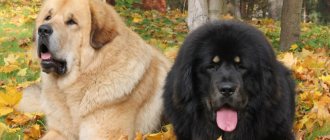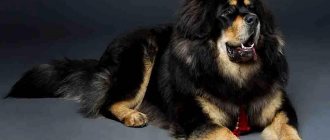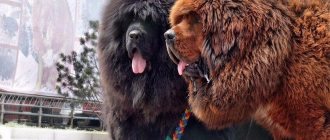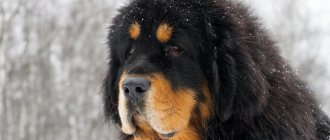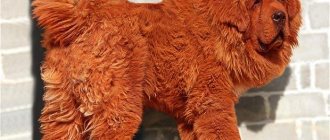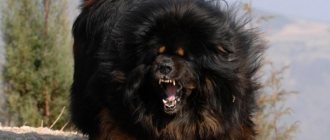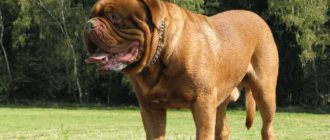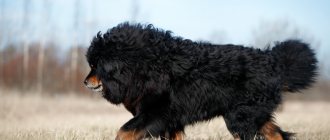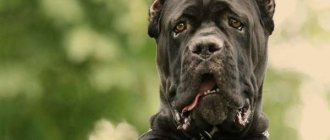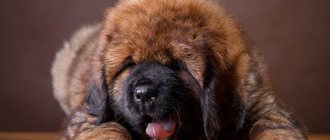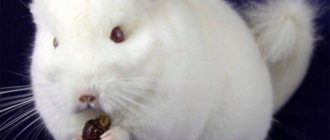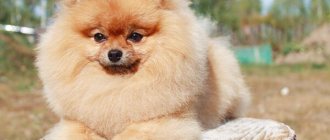Not many people know about this breed of dog, the Tibetan Mastiff. Indeed, today it is quite rare. This breed belongs to the group of Swiss mountain and cattle dogs, Molossers, Pinschers and Schnauzers. What was the Tibetan Mastiff originally bred for? This breed is the most ancient working breed. Dogs belonging to it were used in Tibetan monasteries as guard dogs, and nomads, whose habitat was the Himalayas, valued them as their faithful helpers.
Origin story
You can understand where the Tibetan mastiff comes from from its name. The natural conditions of the mountains are known to be quite harsh. Because of this, Tibetan Mastiffs had to become strong and resilient in order to successfully adapt to their environment. In the mountains they were not influenced by the outside world, thanks to which the breed retained its purity and its strong qualities.
The first mentions of Tibetan mastiffs date back to ancient times. Aristotle had a chance to meet these dogs when he traveled through Asia. Mastiffs and Marco Polos have been noted. These researchers described the breed in their writings, praising the animals' fortitude and endurance. Other travelers also admired the Tibetan mastiffs. There is an assumption that it was from this breed that the Molosser group was subsequently formed.
Despite its ancient origins, the mastiff appeared in Europe only in the 19th century. The dog was presented as a gift to the Queen of England. Somewhat later, Edward VII brought two more such dogs from his trip to Asia. In 1898, the first litter of Tibetan mastiffs appeared in the Berlin Zoo in Europe.
List of nicknames
More often, Tibetan puppies are given Chinese nicknames. The names of male dogs symbolize power and strength. Girls are given softer – cheerful and cheerful nicknames.
Boys according to this principle can be called: Abramid (incredible), Cheng (powerful), Zian (good watchman). For girls, nicknames such as Lubsama (smart), Gunga (joyful), Xiu (loves children) are suitable.
Other nicknames for male dogs:
- Rider, Olympus, Akbar, Apollo;
- Nike, Kazbek, Badi, Rastley, Murphy;
- Caesar, Tucker, Oscar, Clyde;
- Bek, Horus, Rusty, Lucius, Polkan;
- Claude, Butch, Fred, Rudolph, Ray;
- Monty, Oton, Dustin, Stif, Luke;
- Diesel, Cooper, Scooby, Chase;
- Rex, Marcel, Troy, Ernie, Newman;
- Lloyd, Ringo, Adrian, Persian, Pulion, Titus, Frank.
Nicknames for girls:
- Jess, Fanny, Chasey, Piggy, Zlata;
- Cassie, Ulli, Emmy, Doxie, Ulma;
- Lucky, Rhonda, Chita, Ollie, Fiona;
- Sheldi, Alma, Zara, Tosya, Adele;
- Alice, Ada, Hera, Chessa, Gina;
- Dana, Helga, Diya, Zhulya, Gizma;
- Cessa, Lexi, Tracy, Abby, Viva, Strelka, Sophie.
Interesting Facts
The Tibetan Mastiff is without a doubt one of the largest dogs. However, there is evidence that in former times the size of some individuals of this breed was comparable to that of a donkey.
These dogs are considered the most expensive on our planet. Thus, in 2009, the price for a Tibetan Mastiff puppy was set at 600 thousand dollars (a little more than 40.6 million rubles), and relatively recently one Chinese billionaire paid 10 million yuan for a young dog of this breed. This amount is 1.5 million dollars, or 101 million 536 thousand rubles.
There is a legend according to which the owner of such a dog was Buddha himself.
The Tibetan mastiff is so strong that there are cases when he won fights between wolves and snow leopards.
Having long and lush hair, the dog sleeps peacefully in the snow. She can also spend a long time in bad weather or on ice.
The Mastiff is considered an excellent watchdog. In former times, these dogs were kept on a leash during the day and released at night to protect the territory from enemies and predators. This way of life is not alien to Tibetans even in modern times. They have not lost the habit of dozing during the day and being active at night.
Conclusion
The Tibetan Mastiff was bred in China for protection. Later, thanks to the king of Nepal, the breed spread throughout European countries and America. For Russia, this mountain dog is a rarity, but is in great demand, which is why it is expensive (75-150 thousand rubles).
The Mastiff is in good health (especially girls), he is a born guard and is ready to constantly monitor his possessions. This dog is designed for a large area; it will be cramped in an apartment. Proper upbringing from puppyhood will make the Tibetan giant an obedient and friendly family member.
Breed standard
The Tibetan Mastiff's coat is thick and smooth. This is why animals can be kept outdoors all year round without any problems.
An adult Tibetan mastiff reaches a weight of 60-80 kg. At the same time, the height at the withers of the dog is 60-77 cm. The upper limits of these indicators remain open for the Tibetan mastiff. The main thing for the breed is maintaining the required proportions.
Head
What makes the Tibetan Mastiff different? Strong, voluminous and heavy head. An adult Tibetan Mastiff may have folds between the corners of the mouth and the eyes.
The massive skull of individuals of this breed is rounded at the top and square at the bottom. The bump on the back of the head, as well as the transition from the muzzle to the forehead, are clearly visible in these dogs. What proportions should the individuals have? Compliance with the breed standard is the distance from the occipital protuberance to the transition of the muzzle to the area of the forehead called the stop. It should be equal to the distance from the same stop to the nose. In some cases it is acceptable for the muzzle to be slightly smaller.
As for the jaws, ideally they have a straight or scissor bite. A purebred dog's teeth are always complete and tightly set. The lower jaw is closed with pronounced lips.
The Tibetan Mastiff's eyes are wide apart. According to the breed standard, they should be medium in size, oval in shape and slightly sloping. Tibetans have a proud and impressive expression in their eyes. The eyelids cover the eyeballs quite tightly.
The dog has hanging triangular ears. They are located at the level between the skull and eyes. The ears are covered with soft short hairs and are of medium size; they are slightly tilted forward and slightly raised if the dog is in an excited state.
The neck of the Tibetan Mastiff is quite powerful, with well-developed muscles. It has the shape of an arc with a small dewlap (skin folds).
Frame
The Tibetan Mastiff is distinguished by a muscular back and a straight line of the spine. The body of a dog of this breed has a rather voluminous, flat-shaped croup. The chest, reaching the elbow joints, is of medium volume. The ribs when curved resemble the shape of a heart. The breed standard contains the proportions of the ratio of the length of the body of an individual to its height. The first parameter should be slightly larger than the second.
The tail of the Tibetan Mastiff has a high set and medium length. It is located at the level of the spine line. If the dog is alert or excited, it raises its tail and easily throws it over its back.
We teach correctly
The Tibetan Mastiff is an independent and stubborn dog. Therefore, care alone will not be enough for her. From the first days a puppy appears in your home, you need to start raising and training it. Communication with your pet should be friendly, strict, without unnecessary emotions or aggression on your part.
Dogs of this breed are not particularly energetic and tend to make their own decisions. You will have to make every effort to make your pet respect and obey you. Therefore, training a Tibetan mastiff should begin with a general obedience course so that the animal can immediately adapt to new conditions.
Teaching a dog good behavior and manners includes teaching it a name, a toilet, a place, a feeding and walking schedule, and grooming procedures. Raising a pet must be combined with the basics of training, reinforcing each skill with the appropriate commands: “Come”, “Toilet”, “Place”, “Eat”, “Stand”, “Sit”, “Walk”.
Be sure to teach your puppy no commands. Use the "Fu" order if you want to stop the dog's action at the moment. The “No” order should stop any actions of your pet that are objectionable to you once and for all.
Remember, the Tibetan Mastiff, due to its stubborn nature, may not immediately begin to carry out your instructions. But if you can get him to learn a certain skill, then he will stay with the dog for a long time. However, do not forget to repeat the material covered from time to time, otherwise your pet may decide that the previous lessons no longer need to be completed.
Additionally, the dog will need to take a UGS (controlled city dog) course. Also, it would not be amiss for the Tibetan Mastiff to additionally take a course in training in the skills of protective guard service.
Tell us, how do you keep, feed, raise and train your dog?
Wool
The quality of the Tibetan Mastiff's coat is much more important than its quantity. Moreover, females generally have fewer hairs, while males have more. The coat of purebred Tibetan mastiffs should not have waves or curls, and should also be soft and silky to the touch.
A distinctive feature of the breed is its luxurious mane. It looks like a lion's and covers the shoulders and neck of the dog. In the upper part of the hind legs, the covering looks like a kind of pants.
Conditions of detention
Despite the high cost of mastiff puppies, starting from 50,000 rubles, the popularity of this breed is very high. The advantages of dogs include:
- impressive appearance, luxurious long hair visually increases the already small size of the dog, and the thick lion's mane is a distinctive feature of the breed;
- unpretentiousness and disease resistance;
- calm character and strong psyche;
- good security qualities;
- Despite its size, an adult mastiff eats little; 400-600 g of food per day is enough for him.
Color
Tibetan Mastiffs can be:
- black;
- black and tan;
- blue;
- blue and tan;
- golden with a tone from fawn to rich red;
- sable
Tan marks can be of various shades - from red to dark brown. Depending on the coat, the dog's eyes have a brown tint. The standard says that the darkest eye color is the most preferred. Mastiffs should also have black lips and noses.
Breed Features
Due to the fact that Tibetan mastiffs were kept in only one closed area for many centuries, the breed remained strong and healthy. Adults practically do not get sick.
The optimal conditions for keeping a Tibetan mastiff are outdoors. Dogs feel better in a backyard. Of course, apartment owners can also get such a breed, but it will be much more difficult. The Mastiff will require long walks to satisfy its exercise needs, as well as more careful training.
In addition, in a city environment, the dog will have to adapt to a variety of smells and sounds, to the noise of the streets, to people with children passing by, to loud groups of teenagers and to other animals. In addition, the fur of an individual living in an apartment will not be as luxurious and thick as that of mastiffs who are constantly outdoors.
One of the great advantages of the breed is the absence of the smell characteristic of dogs. Even those people who suffer from allergies to wool can have such animals. The pet will not cause any concern for those who cannot stand the smell of “dog” in the house.
The main decoration of the breed is its coat. How to care for a Tibetan Mastiff so that the coat remains healthy and thick? It is worth noting that this is not difficult at all. All you need to do is perform standard hygiene procedures that do not take much time from the owners. These dogs shed only once a year.
The Tibetan Mastiff is perfect for our harsh northern climate. And this is thanks to his good health, excellent immunity and thick coat. A dog that lives on a personal plot does not need to be allowed into the house, even if it is thirty degrees below zero outside.
Mastiff puppies are very touching and cute. They resemble teddy bears. Like all kids, they are playful, restless and active. However, an older dog becomes balanced and calm.
The process of raising a Tibetan Mastiff should begin as early as possible. This way puppies quickly adapt to humans and the outside world. However, you should not overload the kids. Until they are 1-1.5 years old, they should not receive too much stress. Growing dogs have fragile bones, and because they grow quickly and weigh quite a lot, they need to be protected from all kinds of injuries.
The Tibetan Mastiff (we discuss caring for it in the article) is a territorial animal. The dog perfectly protects both its owners and the square meters provided to it, namely a vegetable garden, a plot or even part of a street. Having settled on their territory, mastiffs choose the highest point on it, from which they observe what is happening and perform their guard duty.
Reviews
Externally, the mastiff is similar to a lion, has the same mane, and has a terrifying appearance. It's better not to keep it in the apartment. The animal is smart and kind, and treats small children with love. Like a big toy for them.
The Mastiff constantly frolics, is always on the move. The dog is easy to train and quickly learns commands. This is a great companion for sports.
The Mastiff is a born guard. You just need to immediately determine that the pet is allowed to guard, otherwise the dog begins to protect everything.
Dog character
These are not easy animals. Their character has its own characteristics. Judging by the reviews, it is better to get a Tibetan Mastiff for those people who already have experience in keeping and raising these dogs. After all, it will take a lot of effort from the owner to make his pet obedient. From a very young age, the Tibetan Mastiff needs to be instilled with a love for people. And at the same time, it must be trained persistently so that the animal’s obedience is perfect.
Judging by the reviews, the Tibetan Mastiff keeps its aggression under control. But at the same time, the dog is willful. If you raise a puppy correctly, the adult will become a good friend and a wonderful nanny for children.
The Tibetan Mastiff feels very good around a person. After all, the dog is very social. She becomes attached to the owner and then wants to be with him everywhere and always, joyfully responding to the offer to play.
By its temperament and character, the Tibetan mastiff is kind and calm. These are discreet animals that are friendly towards other dogs. Nevertheless, if they notice even the slightest manifestation of aggression, they are quite ready to give an adequate response at any moment.
Due to their guard mission, Tibetans are a little reserved and suspicious of strangers.
In terms of their level of intelligence, mastiffs resemble Great Danes. They are very smart, but at the same time they like to be stubborn.
The character of the Tibetan Mastiff is quite expressive and bright, friendly and unusually harmonious. This dog has never been accused of being a loose dog. Experts compare the voice of this animal with the deep and dull beat that a copper gong makes. In China, for example, the velvety timbre of the bark produced by Tibet was especially appreciated. And for this purpose, the dogs were specially given heated milk. But the mastiff rarely gives voice. He will not burst into senseless barking to scare a passerby he doesn’t like. Even without this, the dog will be able to stand up for its loved ones and for itself.
Due to its character, the Tibetan Mastiff is able to make independent decisions in certain situations. So, when a guest comes to the owner, the dog understands that there is no danger, and he will calmly move aside. However, in cases where an ill-wisher comes to the house, Tibet will boldly rush to the owner’s defense. This happens thanks to the unusually developed intelligence and instinct of the animal. Even Tibetan sages confirmed these qualities. They said this dog never sleeps. Indeed, the animal guards its owner so sensitively that if danger arises, it will instantly wake up and immediately begin active actions.
The character of the Tibetan mastiff does not allow him to bother a person with importunity. The dog will run around the area, lazily chill in the shade or lie in the sun, without approaching the owner. But as soon as he shows affection, Tibet will respond to it, and will do it with great pleasure. Kind words, stroking and touching have a calming effect on the dog. At the same time, communication with the owner and with all household members gives the mastiff great joy.
Due to its character, the Tibetan Mastiff unconditionally obeys the person who is in charge in the house. The rest of the family members receive loyalty, respect and affection from the pet. The big furry pet has a brave and loyal heart. There is enough for all the people he loves. And how happy he is when his owners return from work or a trip! This character trait should be taken into account by anyone who dreams of being greeted by a loving and devoted pet upon arriving home.
How does the Tibetan Mastiff relate to children? If there is a child in the house, then the dog is perfectly aware that there is a little fool in front of it. No amount of childish pranks, fussing or pestering can cause aggression in a Tibetan. Experts agree that in this case you will have to think about the peace of the dog, and not about the safety of your child. The baby can pat the Tibet, climb up to the animal with caresses, run after it, sit astride it. The Mastiff will only endure it philosophically. Little guests who come to the child and form a noisy company will have to explain that a playful fuss can be mistaken by the dog for a fight, which will give it the right to intervene to restore order.
Another remarkable character trait of the Tibetan Mastiff is its sense of dignity, expressed in the majestic poise of the animal. But at the same time it would be wrong to call the dog a phlegmatic person. After all, this pet is distinguished by its mobility and curiosity, playfulness and liveliness of mind, and in addition to all this, it has a sense of humor. The animal exhibits all of the above character traits in accordance with the current situation. So, when the family is alone with the dog, despite its gigantic size, it behaves like a playful and gentle kitten. In the presence of unfamiliar guests, Tibet is an attentive observer. He doesn’t get in the way, but at the same time constantly controls the situation. When danger arises, the mastiff turns into an unrivaled guard. But the most important character trait of this animal is devotion and fidelity, which it literally radiates with its gaze, movements and every cell of the body.
Selection rules
When choosing a Tibetan mastiff, you need to understand that the dog is designed for a spacious area. Active kids carefully explore everything around them; dogs can cause mayhem. You need to be prepared for this.
The future owner should look at the behavior of the puppies. The healthiest representatives of the breed in the litter are fat, active, strong and cocky. Girls get sick less often, they are calmer and learn faster, and become very attached to their owner. Boys are much more active and, due to their restlessness, are more difficult to train at home.
A purebred dog, according to standards, must have a wide muzzle, a powerful jaw, and a tight bite. The bark of both boys and girls is dull and low. But mastiff bitches have less hair, and the undercoat is thicker and more luxuriant. The tail stands high, curls into a ring, and lies close to the back.
Expert opinion
Anna Abramenko
An avid dog lover. Experience in veterinary medicine since 2009.
Ask a Question
It is not recommended to take an adult dog. Most mastiffs recognize only their first owner, although there are exceptions with a good-natured attitude towards the dog.
Hygiene and care
Your pet's thick coat will require extra attention. After all, its cover is the pride of the breed. In addition, Tibet will need to ensure hygiene of nails, teeth, ears and eyes. How should you care for your dog?
- During shedding, the dog's fur must be combed three times a day, using special brushes.
- It is enough to bathe your pet twice a year.
- If tangled balls of hair or tangles appear, they are carefully cut off.
- It is recommended to brush your dog’s teeth twice a week for preventive purposes, and when changing them, constantly monitor the condition of the gums and the formation of the bite.
- The animal's claws are trimmed with special devices twice a month.
- After returning from a walk, you need to inspect the Tibet's paws, rinse them with clean water and wipe them with a soft cloth.
- You can remove accumulations of dust or wax from your ears by wiping them with wet wipes.
- The mastiff's eyes should be washed periodically using an infusion of chamomile.
Diet
Your pet's menu should contain only natural products or fully prepared wet and dry food. Moreover, such food should only be given separately. Mixing it is strictly prohibited.
How to feed a Tibetan Mastiff puppy? A small pet needs to be fed six times a day, evenly distributing the required daily amount of food. The list of products that must be included in the Tibetan diet includes:
- lean meat;
- by-products that have undergone heat treatment;
- dairy products;
- cereals (buckwheat or rice);
- boiled eggs;
- vegetable oils;
- boiled vegetables;
- dried fruits, raisins and cheese, as encouragement during training;
- any greens.
Your pet's food should also contain vitamin and mineral supplements. They are prescribed by a veterinarian based on the dog’s health and age. From two months to one year, puppies are fed five times a day. During this period, their diet includes additional boiled sea fish without bones.
Training and education
As mentioned above, the Tibetan Mastiff requires early socialization. And for this you need to properly raise your pet, and start doing this as early as possible.
How to train a Tibetan Mastiff? The standard components of this process are:
- socialization;
- imprinting;
- passing the general course.
Imprinting is a complex of using special techniques. Thanks to them, the puppy gets used to the owner, stops being afraid of him and begins to trust him completely. Such classes are conducted at the very first stage of education. At the same time, the dog acquires the skills of an adequate attitude towards the environment and society.
After imprinting, the socialization of the dog begins. At the same time, she is taught to calmly react to the world around her and to society. Only a fully socialized animal is able to begin mastering the training course and follow basic commands.
Purchasing a Tibetan Mastiff
It is better to buy a purebred dog from a kennel or on the recommendation of a club. Experienced breeders will give the necessary instructions regarding the animal’s diet and maintenance.
What is the price of a Tibetan Mastiff? The amount assigned for a purebred puppy will depend on many factors. Among them:
- pedigree parameters;
- opportunity to participate in exhibitions;
- parental origin;
- natural type.
In Moscow nurseries, for example, a male mastiff of the highest class can sell for 100-120 thousand rubles. Adults belonging to the category “pets” cost 40-50 thousand rubles in Russia.
How to choose a puppy
If you want to be sure that your future pet is purebred, then you need to buy it from experienced breeders in specialized nurseries. Those who are interested in the pedigree of the Tibetan Mastiff should inquire about it in advance. Ask the breeders to provide all information about the puppy's parents. It will be useful to you if you are going to attend exhibitions with your dog and participate in competitions with him. In leading nurseries there is literally a queue for purebred puppies. Therefore, you can pre-book a puppy from a couple who are planning to breed. Or choose it when the babies are already born.
When you first meet puppies, pay attention to the condition in which they and their mother are kept. The room must be clean. The Tibetan Mastiff female should receive adequate nutrition. When choosing your future pet, pay attention to its appearance. The coat should be thick and shiny. The eyes should not water. The puppy should be well-fed, with wide paws and a muzzle. In appearance he looks like a bear cub.
See how the baby behaves. He should not be afraid of you or show aggression. All these qualities are considered a vice. The puppy must show interest in the new person and be interested in playing with him.
